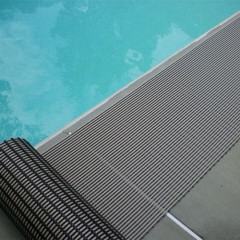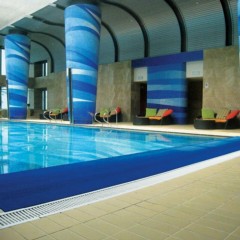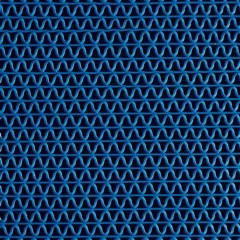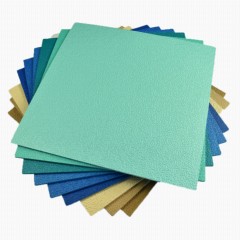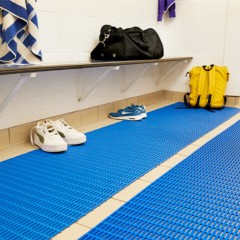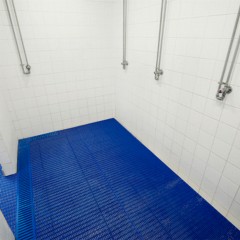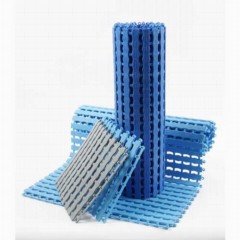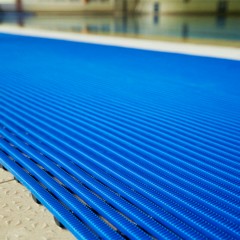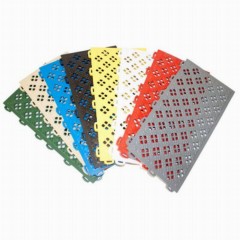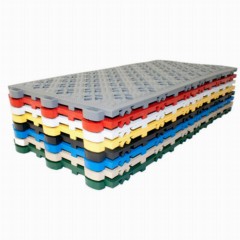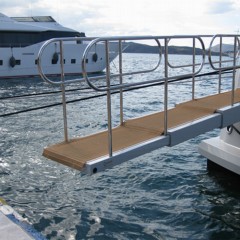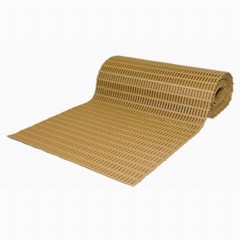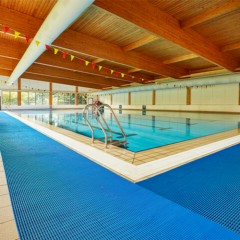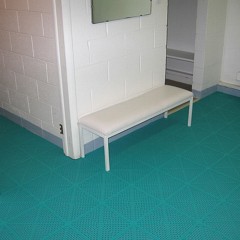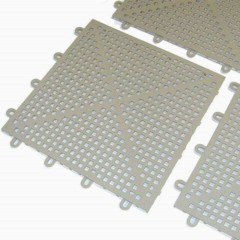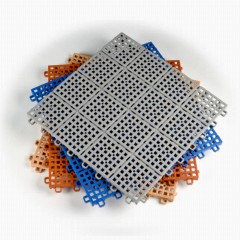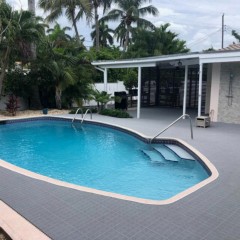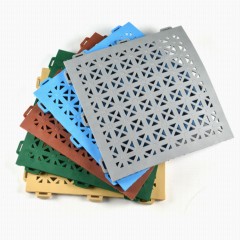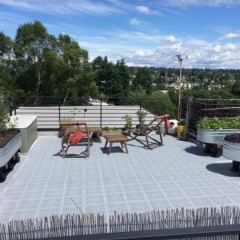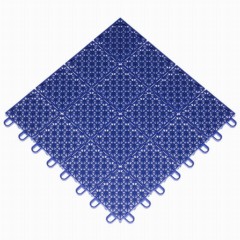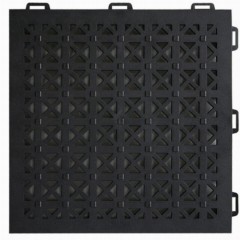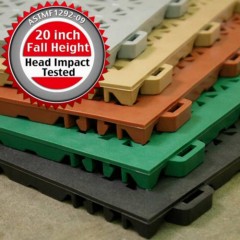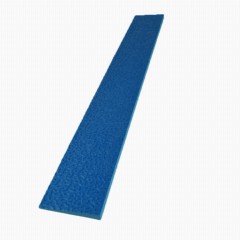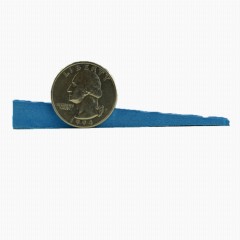Options for Aquatic Matting
Aquatic matting serves many purposes around a pool area, sauna, hot tub, splash pad, or locker room shower. Swimming pool safety matting offers good traction when wet while resisting the formation of mold and mildew. In a constantly wet area at an aquatic center, pool deck surround, or locker room, our poolside matting minimizes maintenance requirements while yielding a far more comfortable surface than bare concrete. It’s available in several colors, too, allowing you to create a fun, vibrant place to hang out. Selecting pool matting from Greatmats will make a huge splash with your customers and patrons – no diving board or belly flops needed!
Types of Aquatic Flooring
We offer three primary designs of aquatic matting, depending on the coverage requirements and installation method you want to use.
Matting Rolls
Our matting rolls consist of PVC plastic and vinyl materials offered in a range of colors and coverage sizes. They provide slip resistance, perforated designs, anti-microbial properties, and anti-fungal properties. They feel comfortable underneath bare feet. You can install them temporarily or permanently. Some of the models include:
AquaTile
Our
AquaTile Aquatic Flooring uses a solid surface design, rather than perforations, but it still yields a safe area that stands up to all safety requirements and industry standards.
Each EVA rubber polymer tile measures 2x2 feet and includes non-standard colors that will allow your water park, pool deck, or splash pad to stand out from the crowd. Chemical shock applications to the water or UV rays from the sun do not affect the color integrity of the tile. It requires a permanent glue-down installation.
Interlocking Tiles
Our interlocking tiles for pool surrounds are easy to install for permanent or temporary layouts. We offer designs with perforations to quickly drain away splashed water, as well as solid surface designs. Multiple colors are available in the slip-resistant PVC plastic and polypropylene plastic. PVC plastic feels softer underfoot, while polypropylene plastic tiles are extremely durable. Some specific models include:
Benefits of Aquatic Matting
Some of the key benefits of our pool safety mats and aquatic flooring include:
- Multiple shapes and coverage sizes
- Multiple colors
- Perforated designs for draining standing water
- Safe to use indoors or outdoors
- Cushioned under bare feet
- Durable in wet conditions
- Mold- and mildew-resistant
- Easy to install
- Doesn’t need special cleaning techniques
- Some designs offer fall-height protection
Use Types for Aquatic Floors
When you select aquatic floor mats from Greatmats, you can deploy them in many different locations, including:
- Commercial pools
- Hotel pools
- Public pools
- Residential pools
- School pools
- Physical therapy pools
- Health clubs
- Locker rooms
- Splash pads
- Saunas
- Hot tub surrounds
- Cold tub surrounds
- Indoor or outdoor showers
Aquatic Matting Q&A
What are the safest indoor waterpark floors?
The
safest indoor waterpark floors are those that provide slip-resistance and comfort underfoot while preventing the formation of mold and mildew. It’s helpful if the pool flooring materials provide a fall-height rating to protect against hard falls around the pool.
What’s the best non-slip splash pad flooring?
The
best non-slip splash pad flooring should provide good traction when wet for people with bare feet who are using it. Vinyl rolls, safety matting, and perforated tiles all provide excellent results when used around a splash pad.
What is the best shower flooring?
The
best shower flooring should be easy to clean, slip-resistant, and perforated to allow water to flow away to the drains underneath. You should match the aquatic mat material you want to use with the planned location, as some materials work better for indoor showers than outdoor showers.
What’s the best flooring for a steam room?
The
best flooring for a steam room should offer waterproof materials, slip-resistance, and comfort underneath bare feet. Having a perforated flooring will allow any standing moisture to flow away to the drain underneath. Tiles available in a variety of colors are especially helpful in creating an inviting atmosphere.
What should you look for in hot tub room flooring?
The
best options for hot tub room flooring include those that provide slip resistance, that prevent the formation of bacteria, mold, and mildew, and that ensure fast drainage of any standing water. Colorful PVC plastic is a common flooring material to use around hot tubs.
 $57843 /Mat You Save 15%$9.64/sqftShips Out in 7-10 Working Days SustainableShop$1,56604 /Roll You Save 15%$11.86/sqftShop$15200 /Mat You Save 14%$10.13/sqftShips Out in 7-10 Working Days SustainableShop$389 /Tile You Save 40%$4.23/sqftShips Out in 1-3 Working DaysShop$630 /Tile You Save 25%$6.30/sqftShips Out in 1-3 Working DaysShop$1,46233 /Carton You Save 15%$9.75/sqftShips Out in 7-10 Working Days SustainableShop$500 /Tile You Save 25%$5.00/sqftShips Out in 1-3 Working DaysShop$1776 /Each You Save 19%$35.52/sqftShips Out in 1-3 Working DaysShop
$57843 /Mat You Save 15%$9.64/sqftShips Out in 7-10 Working Days SustainableShop$1,56604 /Roll You Save 15%$11.86/sqftShop$15200 /Mat You Save 14%$10.13/sqftShips Out in 7-10 Working Days SustainableShop$389 /Tile You Save 40%$4.23/sqftShips Out in 1-3 Working DaysShop$630 /Tile You Save 25%$6.30/sqftShips Out in 1-3 Working DaysShop$1,46233 /Carton You Save 15%$9.75/sqftShips Out in 7-10 Working Days SustainableShop$500 /Tile You Save 25%$5.00/sqftShips Out in 1-3 Working DaysShop$1776 /Each You Save 19%$35.52/sqftShips Out in 1-3 Working DaysShop